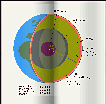
 Theory
Theory 
 Earth's Interior
Earth's Interior
| CONTENT - Earth's inner structure. A tutorial in our series about the Earth |
| |
Earth formed like any other planetary body in the solar system by accretion of planetesimals, heating and differentiation. Due to impacts, radioactivity or tidal gravitational effects, a part of primitive Earth's material melted and that material differentiated into three layers due to density differences: heavier material sank to planet's center forming a planet core, lighter material (mostly basalt and silicates) formed what is called a "mantle", as lightest material floated atop and cooled, forming a thin crust. Hence Earth has a layered structure: a core, a mantle and a crust. Earth has a diameter of 7,900 mi (12,750 km). The Earth, despite plate tectonics or other residual large-scale geological processes, has come to a standstill in terms of global size as geodesists in 2011 determined that the average change in Earth's radius to be
0.004 inches (0.1 millimeters) per year, a rate considered statistically insignificant
- core of the Earth is the densest part of Earth as it is mostly metallic (iron-nickel alloy). It parts into a solid inner core, and an outer liquid core. Inner core has a temperature of 7,800° F (4,300° C) and a radius of 795 mi (1,278 km). It is solid because of the pression existing at Earth's center. It is mostly made of iron. Outer core is 1,370 mi (2,200 km) wide, has a temperature of 6,700° F (3,700° C), is liquid nickel-iron alloy and 10 percent sulfur. Scientists believe Earth's magnetic field results from movements of molten iron and nickel within its liquid outer core, the friction of which is generating electrical currents. Due to the characteristics of those frictions, the Earth's magnetosphere is similarly uneven, moves around in location and varies in strength over time. In just the last 200 million years alone, Earth's magnetic poles have actually reversed hundreds of times, with the most recent reversal taking place about 790,000 years ago. The time span between pole reversals is ranging from 100,000 to several million years. Six slow-moving oscillations, or waves of motion, have beend discovered occurring within the liquid core. The oscillations are originating at the boundary between the core and mantle and traveling inward toward the inner core with decreasing strength. Four of these oscillations are occurring at periods of 85, 50, 35 and 28 years. With pressures close to those inside Earth’s core, researchers may obtain superconductivity at relatively low temperatures
- mantle is a dense, hot layer of semi-molten rock. It is about 2,100 mi (3,400 km) thick. It contains iron, magnesium, calcium, silicon, and oxygen. Mantle is plastic as temperature and pression are high at his depth. Anecdotically, the mineral which makes up more that 70 percent of Earth’s lower mantle lying between 410 and 1,800 miles (660-2,900 kilometers) -or 38 percent of the Earth total, is bridgmanite, a silicate in the perovskite family, named from 1946 Nobel Prize winner Percy Bridgman, a physicist who pioneered the analyses of minerals and other materials under high pressure. Such that mineral is stable only at pressures found below 410 miles from the surface! What scientists call the 410-mile or 660-km boundary has been found with a strong topography, which might impact two layers of Earth's mantle. Water strongly influences the physical properties of the mantle and enhances its ability to melt or convect. A deep hydrated mantle reservoir existed in the Neoarchaean era (2.8 to 2.5 billion years ago) and since at least the Palaeoarchaean era (3.6 to 3.2 billion years ago). Seawater-altered lithosphere recycling into the deep mantle, arguably by subduction, thus started before 3.3 billion years ago
- crust is the outermost, thin layer of Earth. Its thickness varies from 3 mi (5 km) under the oceans, to about 19 mi (30 km) at the continents. It may reach up to 62 mi (100 km) under the large mountain ranges. There crust goes deeper. It is rich in oxygen and silicon with lesser amounts of miscellaneous materials like aluminum, iron, magnesium, calcium, potassium, or sodium. Oceanic crust is made of basalt as continental crust is made of lower density rocks like andesite or granite
This model is further complicated as the uppermost, cooler, part of the mantle is somehow jointed to the crust which is just above it and they behave similarly. Together they are forming the "lithosphere" ("lithos" in Greek means "rock"), which is 50 mi (80 km) thick in average. The lithosphere has been broken into the plates plate tectonics is about. The next layer of the mantle forms the "asthenosphere" ("astenos" in Greek means "weak"). The asthenosphere is found just beneath the lithosphere. It's a narrow, mobile zone made of hot, semi-solid material which can soften and flow after subjected to high temperature and pressure over geologic time. It's the various motions of this system which yields the plate tectonics; asthenosphere is slowly moving. The more rigid lithosphere is floating above, or about it
Website Manager: G. Guichard, site 'Amateur Astronomy,' http://stars5.6te.net. Page Editor: G. Guichard. last edited: 2/25/2019. contact us at ggwebsites@outlook.com

